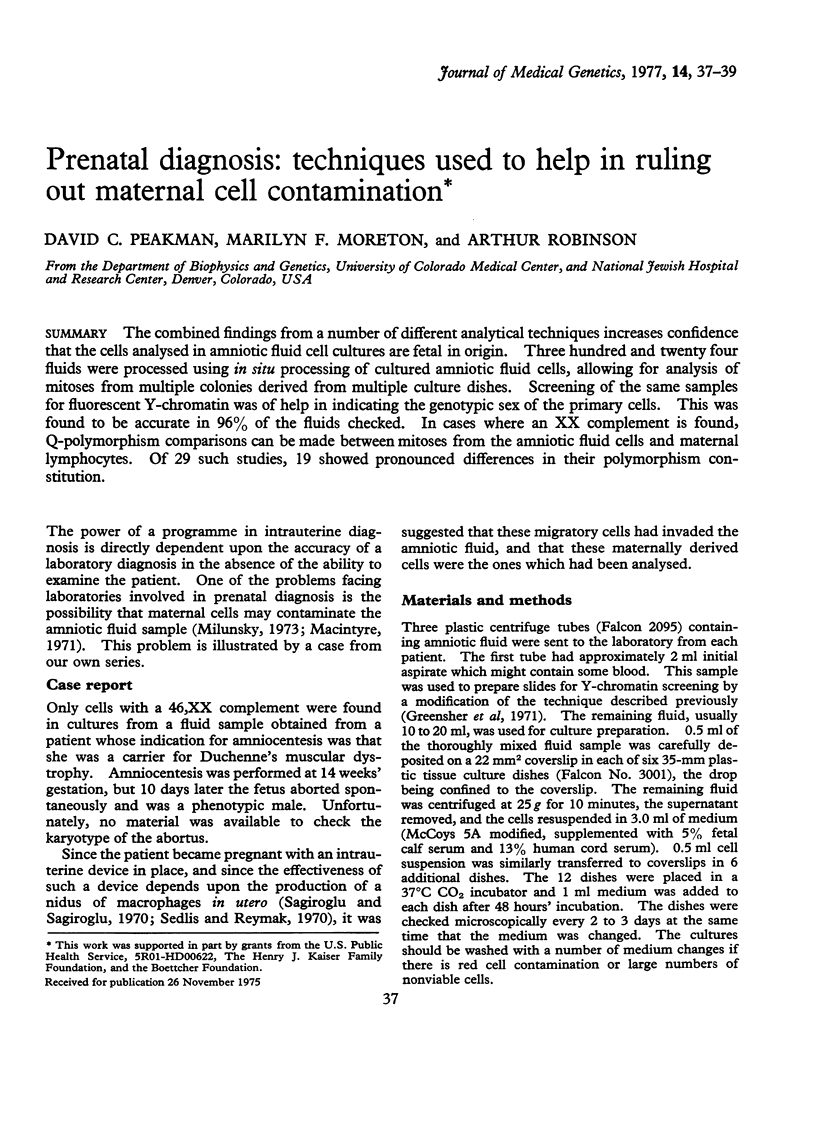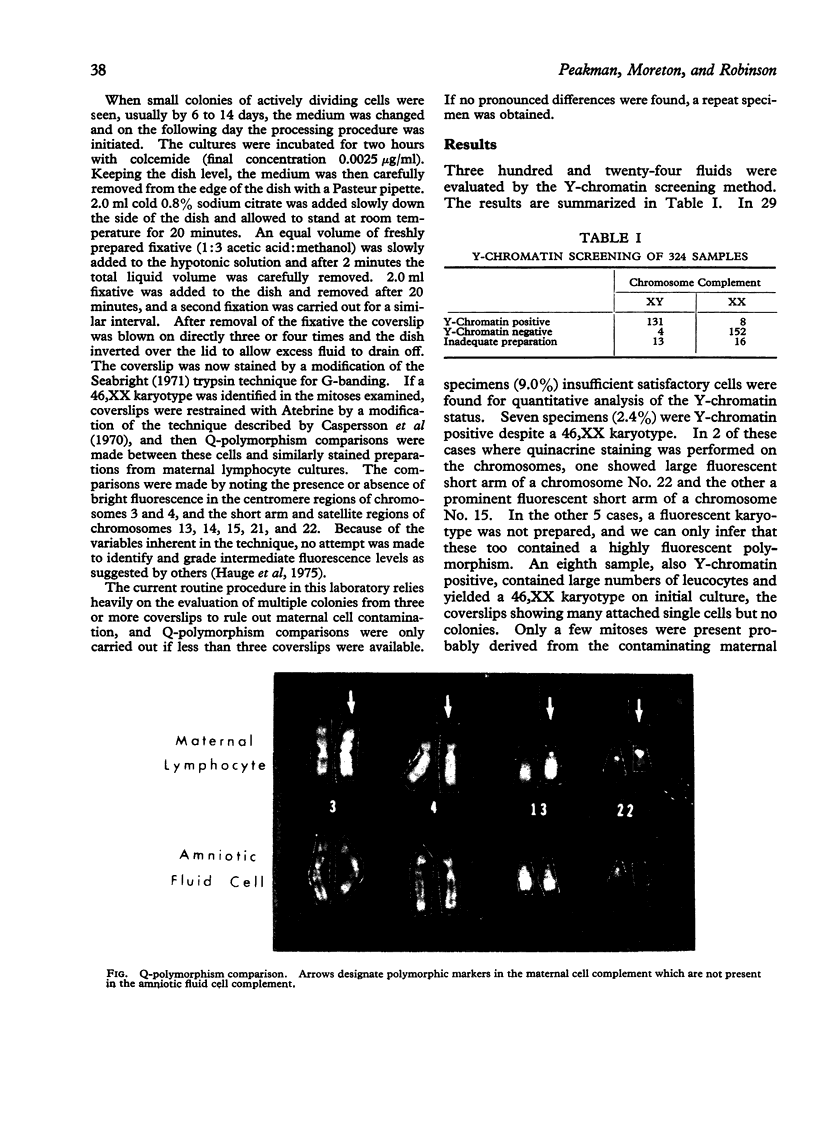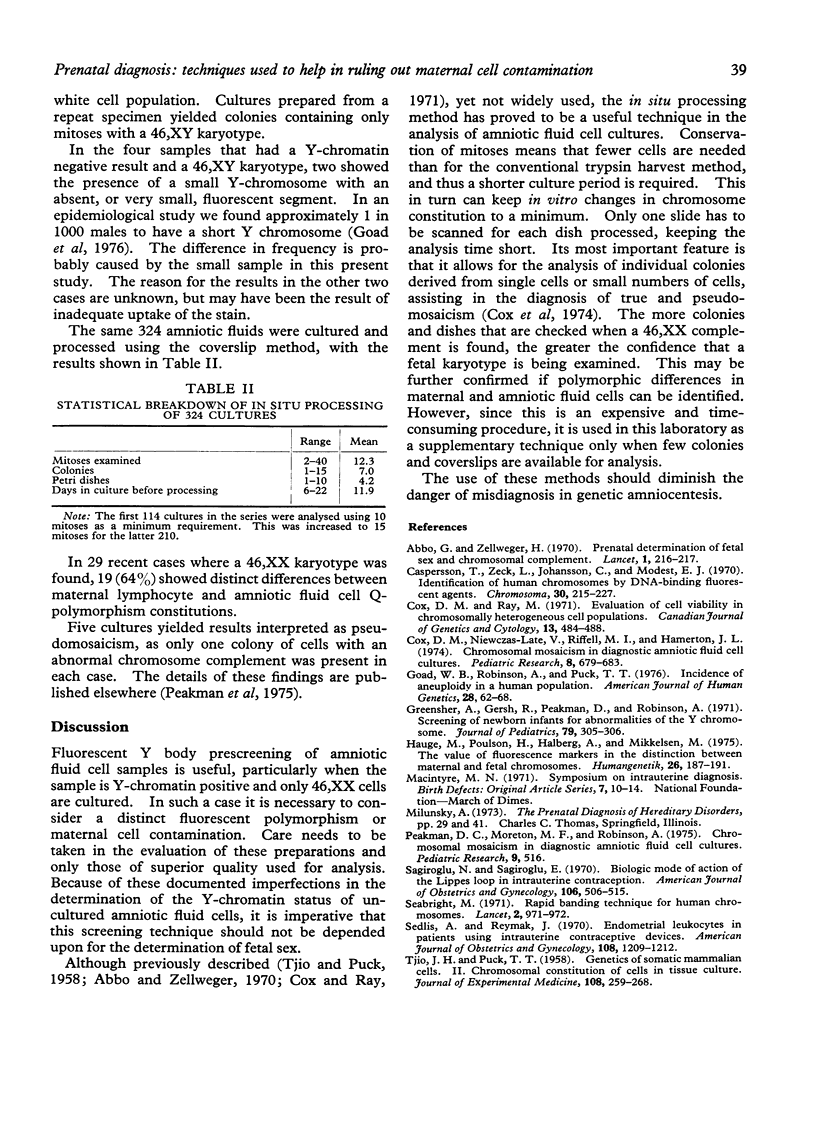Abstract
The combined findings from a number of different analytical techniques increases confidence that the cells analysed in amniotic fluid cell cultures are fetal in origin. Three hundred and twenty four fluids were processed using in situ processing of cultured amniotic fluid cells, allowing for analysis of mitoses from multiple colonies derived from multiple culture dishes. Screening of the same samples for fluorescent Y-chromatin was of help in indicating the genotypic sex of the primary cells. This was found to be accurate in 96% of the fluids checked. In cases where an XX complement is found, Q-polymorphism comparisons can be made between mitoses from the amniotic fluid cells and maternal lymphocytes. Of 29 such studies, 19 showed pronounced differences in their polymorphism constitution.
Full text
PDF


Images in this article
Selected References
These references are in PubMed. This may not be the complete list of references from this article.
- Abbo G., Zellweger H. Prenatal determination of fetal sex and chromosomal complement. Lancet. 1970 Jan 31;1(7640):216–217. doi: 10.1016/s0140-6736(70)90574-x. [DOI] [PubMed] [Google Scholar]
- Caspersson T., Zech L., Johansson C., Modest E. J. Identification of human chromosomes by DNA-binding fluorescent agents. Chromosoma. 1970;30(2):215–227. doi: 10.1007/BF00282002. [DOI] [PubMed] [Google Scholar]
- Cox D. M., Niewczas-Late V., Riffell M. I., Hamerton J. L. Chromosomal mosaicism in diagnostic amniotic fluid cell cultures. Pediatr Res. 1974 Jun;8(6):679–683. doi: 10.1203/00006450-197406000-00009. [DOI] [PubMed] [Google Scholar]
- Cox D. M., Ray M. Evaluation of cell viability in chromosomally heterogeneous cell populations. Can J Genet Cytol. 1971 Sep;13(3):484–488. doi: 10.1139/g71-073. [DOI] [PubMed] [Google Scholar]
- Goad W. B., Robinson A., Puck T. T. Incidence of aneuploidy in a human population. Am J Hum Genet. 1976 Jan;28(1):62–68. [PMC free article] [PubMed] [Google Scholar]
- Greensher A., Gersh R., Peakman D., Robinson A. Screening of newborn infants for abnormalities of the Y chromosome. J Pediatr. 1971 Aug;79(2):305–306. doi: 10.1016/s0022-3476(71)80121-x. [DOI] [PubMed] [Google Scholar]
- Hauge M., Poulsen H., Halberg A., Mikkelsen M. The value of fluorescence markers in the distinction between maternal and fetal chromosomes. Humangenetik. 1975;26(3):187–191. doi: 10.1007/BF00281452. [DOI] [PubMed] [Google Scholar]
- Macintyre M. N. Chromosomal problems of intrauterine diagnosis. Birth Defects Orig Artic Ser. 1971 Apr;7(5):10–14. [PubMed] [Google Scholar]
- Peakman D. C., Moreton M. F., Robinson A. Letter to the editor: Chromosomal mosaicism in amniotic fluid cell cultures. Pediatr Res. 1975 May;9(5):516–516. doi: 10.1203/00006450-197505000-00011. [DOI] [PubMed] [Google Scholar]
- Sağiroğlu N., Sağiroğlu E. Biologic mode of action of the Lippes loop in intrauterine contraception. Am J Obstet Gynecol. 1970 Feb 15;106(4):506–515. [PubMed] [Google Scholar]
- Seabright M. A rapid banding technique for human chromosomes. Lancet. 1971 Oct 30;2(7731):971–972. doi: 10.1016/s0140-6736(71)90287-x. [DOI] [PubMed] [Google Scholar]
- Sedlis A., Reyniak J. V. Endometrial leukocytes in patients using intrauterine contraceptive devices. Am J Obstet Gynecol. 1970 Dec 15;108(8):1209–1212. doi: 10.1016/0002-9378(70)90094-3. [DOI] [PubMed] [Google Scholar]
- TJIO J. H., PUCK T. T. Genetics of somatic mammalian cells. II. Chromosomal constitution of cells in tissue culture. J Exp Med. 1958 Aug 1;108(2):259–268. doi: 10.1084/jem.108.2.259. [DOI] [PMC free article] [PubMed] [Google Scholar]



